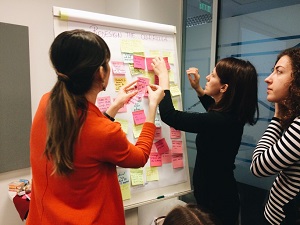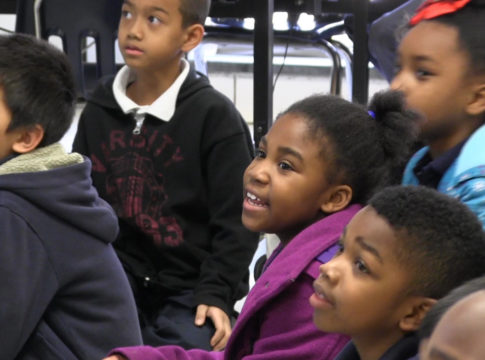
Educators nationally are striving to incorporate more personalization: giving students what they need by adapting what, when, how, and where students learn. But personalized learning is just one of several big instructional trends—high standards, aligned curricula, teaching the whole child, improving social-emotional skills, to name a few. None has achieved its potential.
Personalization, along with those other reforms, is missing a key ingredient: school staffing models to carry reforms, whatever they may be, into millions of classrooms with success.
In typical schools, teachers just don’t have the daily guidance, constant feedback, and support from colleagues to improve fast when trying something new. It’s no surprise that instructional reforms haven’t scaled up with positive results within many individual schools, much less across the nation.

So what new staffing models can help, and how? Innovating educators are beginning to crack the code.
In partnership with the Clayton Christensen Institute, we released school profiles, videos and a report showing how eight schools are personalizing learning and getting results that they attribute to new staffing models. Lead report authors Sharon Kebschull Barrett and Tom Arnett examined district, charter, and private schools serving primarily disadvantaged students and using new staffing models and blended learning.
We already knew about one innovation: multi-classroom leaders in the Opportunity Culture initiative. Third-party research from the Brookings Institution and American Institutes for Research showed their impact: Teachers who were on average at the 50th percentile in student learning gains, who then joined teams led by teacher-leaders known as multi-classroom leaders, or MCLs (who had prior high growth as teachers), produced learning gains equivalent to those of teachers from the 75th to 85th percentile in math, and, in six of the seven statistical models, from 66th to 72nd percentile in reading.
While more research needs to confirm the connection, educators across all the schools we studied with Christensen attributed their student learning outcomes to the guidance, support, and strong relationships among teachers and students catalyzed by these collaborative staffing models. Students enthusiastically touted their increased opportunities to work where and how they preferred, based on their personal goals. All the schools provided tailored instruction in small groups, and in some one-on-one. They shared stories of the time and concern that multiple adults showed for them.
Two critical themes emerged: the importance of relationships—within teaching teams and between teachers and students—and the importance of gathering, analyzing, and quickly acting upon student learning data.

From the changes engendered by new teaching roles, we found these powerful commonalities:
• Innovative roles on a career path. New roles helped multiple adults connect with students and support one another on a career path. Roles included teacher-leaders of small instructional teams, who often planned and directed team teachers’ instruction, coached the teachers, and analyzed data, upholding the school’s focus on high standards; collaborating teachers who worked in teams and supported one another more than typically happens for classroom teachers in traditional schools; support staff who tutored or mentored students, providing more one-on-one or small-group time; and teachers-in-training, who supported other teachers and taught while learning on the job in paid fellowships or residencies, enabling schools to build their own teacher pipelines. Importantly, the schools largely paid for these roles—including those with higher pay—within existing budgets, making them sustainable.
• Adult–student connection. Critically, adults in each role worked directly with students, often in small groups or one on one for a portion of each day.
• Intensive collaboration on small teaching teams. Collaboration let multiple adults share what they learned about each student—personal factors, interests, strengths, and barriers that might affect learning. Teachers gained insight into why students were excelling or stalling, not just what students knew, allowing teachers to personalize how they engaged each student. And collaboration helped develop their instructional skills faster.
• Cultures of intensive coaching. Weekly or even daily observations and feedback supported rapid educator improvement and consistent instruction. Schools designed roles, responsibilities, and schedules to support openness about strengths and improvement opportunities.
• Blended learning for data and differentiation. Blended learning for part of each day provided time for more small-group instruction, and gave teachers real-time student learning data. This helped teachers identify what students knew and the next steps for learning. Schools were able to regroup students frequently, quickly respond to struggling students, and help teachers improve by pinpointing instructional planning and professional development needs.
• Deliberate and careful creation of schedules that made school-day teacher collaboration
These schools showed that what sounds like an impossible task—getting every individual teacher to implement strong personalized learning for a wide range of student developmental needs—is possible, with staffing changes and thoughtful use of blended learning.
Doing this at full scale with strong results may actually be possible, in both charter and district schools, because they used a precious resource that exists everywhere: excellent teachers, who, instead of working alone, expanded their instructional impact by leading small teams and/or collaborating with colleagues. And they did so largely within existing budgets, after limited costs for design and, in pre-existing schools, transition to their models.
While only Multi-Classroom Leadership has the rigorous research needed to link it to student learning gains, all the profiled schools illuminate promising new options. What’s most important: these schools have recognized that staffing models must change to help large numbers of teachers make the big instructional shifts that system leaders want—with a real chance of success.
— Bryan C. Hassel and Emily Ayscue Hassel
Bryan C. Hassel and Emily Ayscue Hassel are Co-Directors of Public Impact.





